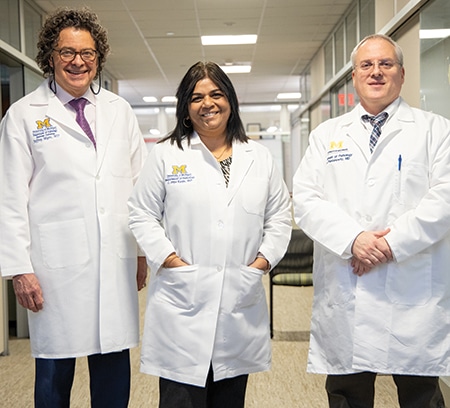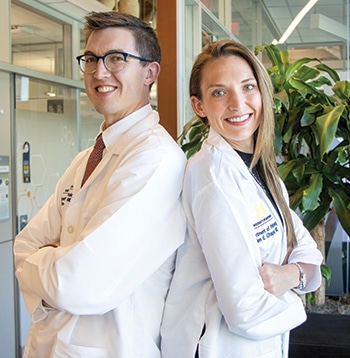Anne Paxton
April 2022—Asked why he robs only trains, Richard Farnsworth’s Gentleman Bandit in The Grey Fox answers with a truth universally acknowledged: “A professional always specializes.” In line with that conviction, there’s little debate on the value of specialization in medicine—or, as it has evolved more recently, the extraordinary value of subspecialization in anatomic pathology. Many consider subspecialist signout to be the gold standard of review and diagnosis in pathology. Because they are dealing with a small number of pathologies, “the care that subspecialists can provide is phenomenal,” says L. Priya Kunju, MD, director of surgical pathology at University of Michigan Health.
But in hospital practice at academic institutions like the University of Michigan, when it comes to time-sensitive frozen sections, subspecialization can have a downside. The need to return a diagnosis of a frozen section within 20 minutes while a surgery is in progress may require that an array of different subspecialists be close at hand, near the operating room. That may not be feasible as laboratories consolidate and pathology departments increasingly move away from the main hospital, Dr. Kunju says.
Jeffrey Myers, MD, A. James French professor of diagnostic pathology and vice chair of clinical affairs and quality in the Michigan Department of Pathology, says pathologists have less and less comfort with doing frozen sections outside their area of subspecialty interest. Virtual tools are of limited help in closing the gap, the laboratory has found. “That makes it very, very difficult to staff for this work, even if you’re at the hospital. And it’s even harder if you’re not,” Dr. Myers says.
In the subspecialty-based culture of the hospital, could a different practice model be required? About two years ago, the department’s Division of Anatomic Pathology started to explore that question by (through a certain irony) developing a new subspecialty: anatomic pathology hospitalists. With the hiring nine months ago of their first two AP hospitalists, department leaders believe they may have found the critical missing piece in their workforce—and filled it. In the process, they hope they may be pioneering a far greater role for pathology in clinical practice.
University of Michigan Health, known as Michigan Medicine, confronted a dilemma in 2018 when it consolidated most of its laboratory services in a central lab in the North Campus Research Complex (NCRC), located three miles from the main hospital, moving its non-stat clinical laboratories out of the hospital along with most of the clinical faculty offices. Previously, the pathologists were within a short walk of the main hospital’s operating room, says David Chapel, MD, assistant professor of pathology and one of the division’s new AP hospitalists. “So whoever was covering the frozen section service would just go down, do the frozen, then return to their office and keep signing out cases.”
Moving the laboratory was a business decision to consolidate and streamline pathology services while also expanding pathology’s footprint. But there had been practice efficiencies in the pre-NCRC setup at the hospital that were lost, Dr. Kunju says. The frozen sections, she explains, are almost like a general surgical department. “You need to know enough over a wide breadth of pathology” to handle the work. “In the hospital, if you had a complex case and you needed help, the subspecialists were right there close by.” But when departments move away from the main hospital, those efficiencies can disappear.
“Faculty, more and more—and this is not limited to Michigan but is across the board—tend to limit their participation by subspecialty interest,” Dr. Kunju says. “There is almost a potential sense of lack of competence to serve the needs of general surgical pathology. Because you’re so much of an expert in one field that you feel you cannot optimally serve the patient’s needs.”

Dr. Jeffrey Myers (from left), Dr. L. Priya Kunju, and Dr. Liron Pantanowitz. “We were creative in developing a job description for an AP hospitalist,” Dr. Pantanowitz says, “because we wanted to fashion a new position that would not just be viewed as a stepping-stone to get into our department, but as a formal career pathway.” [Photo by: Camren Clouthier]
Dr. Myers agrees that small private practice groups are on the decline and large group practices are becoming the norm. “I’ve heard from many practices that as a consequence of subspecialization, hospital-based work that previously was done by one or two people is now done by 10 or 15 people.”
At the hospital, Dr. Kunju sometimes tells junior faculty who are starting frozen sections: “You don’t have to be a hero in the frozen section. You need a more general surgical pathology mindset. Sometimes, realistically, you just have to answer the question the surgeon wants, and you don’t need to give a detailed explanation. Is the margin positive? Do I think it is cancer? Do they need to take more tissue? Do they need to do extra surgery?”
At Michigan Medicine, each pathologist has their subspecialty research interest. “We are an academic institution and we don’t have a generalized surgical pathology model for signing out cases,” Dr. Kunju says. “So more and more pathologists started saying, ‘I’m not comfortable doing a frozen on pancreas because I don’t sign those cases out.’ Many have said, ‘I want the experts to do that.’”
“So we started saying, okay, we are essentially saying frozen sections are like a service. Maybe we have to think of the hospitalist as a subspecialty.”
In hospital work, Dr. Myers says, “we tend to bring way too much expertise to a substantial subset of cases at great expense.” From his perspective, Michigan’s anatomic pathology hospitalist experiment is an opportunity to think differently about that disproportion.
After the laboratory’s move to the North Campus Research Complex, there were benefits to having most of the pathologists under one roof in a spacious laboratory, says Liron Pantanowitz, MD, MHA, director of the Division of Anatomic Pathology. But back at the hospital, there was a scramble to adjust. “We had to use many subspecialized faculty, whom we called our frozen section SWAT team, to share in covering the frozen section service.”Faculty morale eroded after the move, Dr. Myers says, largely due to frozen sections, the “800-pound gorilla” when it comes to hospital service provided by anatomic pathologists.
As pathologists have retired and those in subspecialty roles have increased in number, “there’s less and less comfort with doing frozen sections outside your area of subspecialty interest, which is very, very difficult.”
“In a subspecialized academic practice, people don’t feel good about having to spend the day elsewhere to do frozen sections. And our performance in those roles deteriorated, at least in terms of turnaround. I thought it was time to ask how might we do this differently. And I thought that the AP hospitalist experiment was the right experiment to run.”

Drs. David and Ellen Chapel had just completed their AP fellowships at Brigham and Women’s Hospital when they saw the ad last year for two AP hospitalists. “The idea,” Ellen says, “was that by having dedicated hospitalists, we would essentially provide the face for the department to the different technical teams. And that is already starting to take root.” [Photo by: Camren Clouthier]
“I think we’ve learned from radiology,” Dr. Myers adds, “that if you disappear by virtue of digital solutions, people forget the value you bring to the care they provide.” He also feels pathology may have lagged behind other professions in figuring out how to deploy its subspecialist experts.
The AP division had evidence-based data to confirm that the frozen section arrangement in place was costly and unnecessarily burdensome to the faculty. “Looking at the number of pathology FTEs required to cover the hospital frozen section service demonstrated just how taxing this was on our faculty,” Dr. Pantanowitz says. “Hiring pathologist assistants wouldn’t solve this problem.”
“The complexity of our cases and the high volume of our frozen section service demanded having a pathologist on site at the hospital. There was a gap in our workforce and we needed someone who would be on the service all the time,” he says. So although they couldn’t find another hospital in the world to consult about how an AP hospitalist subspecialty could be launched, the AP division came up with a game plan to do so and proceeded to execute it.
The hospitalist role filled by internists developed years ago because the growing complexity of health care was harming continuity of care, Dr. Pantanowitz says. “Hospitals needed an internist who was dedicated to the patient from beginning to end during the inpatient stay.”
Influenced by that model, the AP division saw AP hospitalists as a creative solution to deal with lab consolidation and relocation, he explains. “The move made it difficult to provide daily AP services that occur in the hospital, most notably covering frozen sections, when pathologists are now located off campus. Remotely managing this via telepathology, in our experience, is inadequate for a high-volume intraoperative consultation practice like ours where we can do over 100 frozen sections a day.”
To Dr. Myers’ knowledge, the Michigan pathology department is the first in the country to develop an AP hospitalist subspecialty. “Nobody that I know of has looked at whether you could train pathologists whose subspecialty was intraoperative care across organ-based domains to the competencies required for 90 to 95 percent of the work and see if they could function at a level that competes with their subspecialized colleagues,” he says.
So there were no preexisting help-wanted templates to draw upon, and composing an advertisement for the positions required a balancing act, Dr. Pantanowitz says. “We were creative in developing a job description for an AP hospitalist, because we wanted to fashion a new position that would not just be viewed as a stepping-stone to get into our department, but as a formal career pathway. We wanted them to achieve personal success, but also to academically promote this field.”
When Ellen Chapel, MD, and her spouse, Dr. David Chapel, saw the job opening the department advertised for two AP hospitalists in 2021, they had just completed their AP fellowships at Brigham and Women’s Hospital in Boston—Ellen subspecializing in breast and David in GYN. One thing that drew both of them to the AP hospitalist jobs was the prospect for interaction with other hospital faculty. These were appealing positions because of the intense focus on clinical collaboration, says Ellen, assistant professor of pathology. “We love working with surgeons and clinicians. For both of us it is the most rewarding part of our jobs. We want that to be a huge part of our careers.”The two Drs. Chapel were hired to fill the new roles, and the frozen section work coexists with Ellen’s own clinical work as a breast pathologist and David’s work as a gynecologic pathologist. Part of their job, David says, is not to be at the research complex a lot of time “because we need to be physically in the operating room to do our intraoperative consultations.” David estimates that he works at the hospital 50 to 60 percent of the time.
 CAP TODAY Pathology/Laboratory Medicine/Laboratory Management
CAP TODAY Pathology/Laboratory Medicine/Laboratory Management
